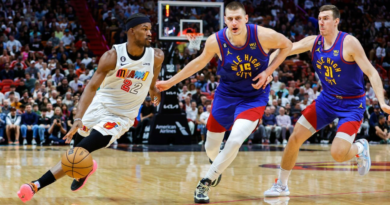WNBA trade grades: Did Phoenix or Chicago do better in Copper trade?
The two teams that met in the 2021 WNBA Finals — when the Chicago Sky knocked off the Phoenix Mercury for the first championship in franchise history — came together Tuesday to complete the biggest trade of the 2024 WNBA offseason to date. Finals MVP Kahleah Copper is headed to the Valley of the Sun in a deal that lands Chicago the No. 3 pick in this year’s WNBA draft and a 2026 first-rounder.
Although the Mercury finished with the WNBA’s worst record last season and the Sky made the playoffs as the eighth and final seed, it’s Phoenix that’s pushing to win now, with Diana Taurasi in the twilight of her career. Copper is the kind of athletic, high-scoring wing the Mercury have long sought to pair with Taurasi and Brittney Griner.
Meanwhile, Chicago is seeking to replenish its draft coffers after last year’s ill-advised sign-and-trade deal that gave up control of the Sky’s first-round picks through 2026 for Marina Mabrey.
What does this trade mean for both teams and the rest of the league? And who got the better value? Let’s break it down.
Mercury get: Forwards Kahleah Copper and Morgan Bertsch
Sky get: Forwards Michaela Onyenwere and Brianna Turner, 2024 No. 3 pick, 2025 second-round pick (via Chicago), 2026 first-round pick and second-round swap (via Phoenix)

Phoenix Mercury: B-
This period in WNBA history reminds me a bit of when the Golden State Warriors added Kevin Durant and other teams, particularly in the Western Conference, had to consider whether to challenge the Warriors or lie in wait for the end of their reign. Amusingly, new Phoenix GM Nick U’Ren was in the Golden State front office at the time.
Like several other WNBA teams, most notably the Seattle Storm loading up with Nneka Ogwumike and former Mercury guard Skylar Diggins-Smith, the Mercury have decided to compete with the star-studded Las Vegas Aces and New York Liberty.
To some extent, that might have been inevitable, given Phoenix’s situation. In addition to the ticking clock on Taurasi’s career at age 41 and Griner’s prime at 33, the Mercury also were confronting not having control of their 2025 first-round pick after agreeing to a swap with the Liberty in the deal that brought Onyenwere to Phoenix last year.
Already, the Mercury had added a pair of starters this offseason via free agency in point guard Natasha Cloud and forward Rebecca Allen, the latter acquired in a sign-and-trade for Moriah Jefferson. Bringing in Copper to go with Griner, Taurasi and holdover Sophie Cunningham completes one of the league’s stronger top-six rotations.
The biggest question for Phoenix’s hopes of advancing in the 2024 playoffs will be the team’s health and depth. Taurasi played 26 games last season and has missed 35 of the Mercury’s 108 games over the past three years. Without her, Phoenix still has five starting-caliber players, but the talent drops off quickly.
Depending on just how much of a discount Griner is willing to take when she officially re-signs with the Mercury, they might be depending on players at the non-veteran minimum to fill out the roster. Even if Phoenix goes with such players, the most the team can offer Griner is a little more than $150,000, per Richard Cohen of HerHoopStats.com.
That makes Bertsch a surprisingly important piece of this trade. With one year of experience, Bertsch doesn’t yet qualify for the veteran minimum. She contributed 14.2 quality minutes off the bench for the Sky last season. Sug Sutton, who signed her qualifying offer to return to the Mercury, is also on the lower minimum after averaging 26.3 MPG in 2023, albeit as an inefficient scorer (.464 true shooting percentage).
The other key question is what level of play Phoenix will get from Taurasi. If she’s willing to move into a complementary role on offense after using 29% of the Mercury’s plays last season, her highest mark since 2011, Taurasi could be a more efficient scorer and have more energy to channel to the defensive end of the court.
Copper can help take the scoring load off of Taurasi. Copper averaged a career-high 18.7 PPG last season, and she had more offensive responsibility with the departures of Chicago’s other four starters from the 2022 team that tied for the league’s best record. Copper’s 2-point percentage took a hit, dropping from 53% to 47% — her lowest since coming off the bench in 2019. However, Copper was able to compensate by hitting a career-high 40% of her 3s, a skill that will fit well spacing the floor for Griner.
The wing spot next to Taurasi has been a revolving door in Phoenix. Kia Nurse was brought in to play small forward in 2021, but her ACL tear during the semifinals necessitated another trade with the Sky, for Diamond DeShields. Last winter, the Mercury swapped out DeShields for Onyenwere. Copper is a better shooter and far more accomplished as a WNBA scorer, making her a massive upgrade in that role — as Phoenix saw firsthand in the 2021 Finals.
The Mercury’s willingness to trade the No. 3 pick after the Storm already dealt away this year’s fourth selection is the latest indication teams don’t expect all of the eligible talent to declare for the 2024 draft. Still, this year’s pick should yield a strong contributor on a rookie contract. And Phoenix giving up its 2026 first-round selection all but forces the Mercury into the same position next year, trying to recruit talent to avoid sending away a lottery pick.
As a result, anything short of a trip to the WNBA semifinals this season will be a disappointing outcome for Phoenix. I’d project the Mercury outside the league’s top four teams, with Seattle sacrificing less depth to add two stars, the Connecticut Sun bringing back their core, and the Dallas Wings and Atlanta Dream on the rise by building around draft picks.

Chicago Sky: A-
The first rule of being in a hole is quit digging. That’s why I have to commend the Sky on the difficult decision to rebuild after losing starters Alanna Smith and Courtney Williams to the Minnesota Lynx in free agency and missing out on Ogwumike as one of three finalists to sign the former MVP.
Given the 2025 pick swap, Chicago could have overpaid veterans in pursuit of another run at the eighth seed, a move that would have left the Sky a year further from legitimate contention. Parting with Copper, who developed into a star in Chicago and was part of the best teams in franchise history, is undoubtedly painful. However, the Sky now have a first-round pick in every draft going forward after previously being out their 2024 and 2026 selections.
It should be heartening that Chicago was in the mix for Ogwumike, suggesting the franchise is still a draw for free agents despite being behind in terms of having a dedicated practice facility. If plans for a facility come together and the Sky’s draft picks show promise, they can use free agency to find the missing pieces to their puzzle down the road.
For now, the Wings are the big winner of this trade as they hold those swap rights with Chicago. Among the four teams that finished behind the Sky in the standings last year, only the rebuilding Los Angeles Sparks project worse in 2024. Based on the WNBA’s use of record over the previous two seasons to determine lottery positioning, Chicago could easily enter with the second-best odds of winning the No. 1 pick in the 2025 draft and sending that pick to Dallas in exchange for one likely to be in the back half of the round.
The Sky’s cupboard isn’t entirely bare. They return starters Mabrey and Elizabeth Williams, and Isabelle Harrison should be healthy after missing 2023 due to knee surgery. The big challenge for first-year Chicago coach Teresa Weatherspoon will be finding efficient shot creation to replace Copper. Dana Evans, who figures to step in at point guard, had a .485 true shooting percentage (TS%) last season. The Sky also brought back DeShields, who sat out 2023 with a knee injury and posted a .472 TS% in 2022 in Phoenix.




